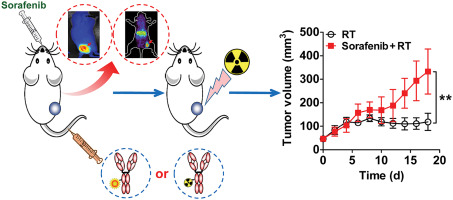Biomaterials ( IF 14.0 ) Pub Date : 2017-12-15 , DOI: 10.1016/j.biomaterials.2017.12.012 Jianhao Lai , Dehua Lu , Chenran Zhang , Hua Zhu , Liquan Gao , Yanpu Wang , Rui Bao , Yang Zhao , Bing Jia , Fan Wang , Zhi Yang , Zhaofei Liu

|
Increasing evidence indicates that the overexpression of galectin-1, a member of the galectin family, is related to tumor progression and invasion, as well as tumor resistance to therapies (e.g., radiotherapy). Herein, we investigated whether near-infrared fluorescence (NIRF) imaging and positron-emission tomography (PET) were sensitive approaches for detecting and quantitating galectin-1 upregulation in vivo. An anti-galectin-1 antibody was labeled with either an NIRF dye or 64Cu, and NIRF and PET imaging using the resulting probes (Dye-αGal-1 and 64Cu- 1,4,7-triazacyclononane-1,4,7-triacetic acid [NOTA]-αGal-1) were performed in 4T1 breast cancer-bearing mice treated with several rounds of sorafenib. Radiotherapy was performed in vitro and in vivo to identify the role of galectin-1 in radioresistance. NIRF and PET imaging both revealed significantly increased upregulation of galectin-1 in the hypoxic tumors after sorafenib treatment, which was verified by ex vivo biodistribution, western blotting, and enzyme-linked immunosorbent assays. Galectin-1 specific inhibition by thiodigalactoside dramatically improved the efficacy of radiotherapy, and overcame sorafenib-induced radiotherapy resistance. Taken together, galectin-1 is a key mediator of tumor resistance to radiotherapy. Targeted molecular imaging allows for real-time, noninvasive, and quantitative detection of the dynamic changes in galectin-1 levels in vivo; this introduces the possibility of early detection of tumor resistance to therapies.
中文翻译:

Galectin-1上调的非侵入性小动物成像可预测肿瘤对放疗的抵抗力
越来越多的证据表明,galectin-1(galectin家族的成员)的过表达与肿瘤的进展和侵袭以及肿瘤对治疗的抵抗力(例如放射疗法)有关。在本文中,我们研究了近红外荧光(NIRF)成像和正电子发射断层扫描(PET)是否是检测和定量体内Galectin-1上调的灵敏方法。抗Galectin-1抗体用NIRF染料或64 Cu标记,并使用所得探针对NIRF和PET成像(Dye-αGal-1和64 Cu-1,4,7 -triazacyclononane -1,4,7 -三乙酸[NOTA]-αGal-1)在经过数轮索拉非尼治疗的4T1乳腺癌小鼠中进行。进行放射治疗在体外和体内鉴定半乳糖凝集素-1在抗辐射中的作用。NIRF和PET成像均显示索拉非尼治疗后低氧肿瘤中半乳凝素1的上调显着增加,这已通过离体生物分布,蛋白质印迹和酶联免疫吸附试验得到了证实。thiodigalactoside对Galectin-1的特异性抑制作用显着提高了放疗的疗效,并克服了索拉非尼诱导的放疗抵抗。总而言之,galectin-1是肿瘤对放疗耐药性的关键介体。靶向分子成像技术可以实时,无创和定量检测体内galectin-1水平的动态变化; 这引入了及早发现肿瘤对治疗的抗性的可能性。



























 京公网安备 11010802027423号
京公网安备 11010802027423号